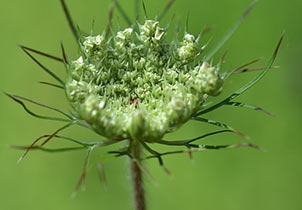What is Chervil?
That subtle, tender flavor-part anise, part parsley-that you’ve been trying to identify in the fish sauce, will almost certainly turn out to be chervil, the most retiring of the sister spices that make up the fines herbes of French cuisine, but one that’s good company and not to be overlooked. Chervil is a member of the Carrot family and its leaves highly resemble carrot tops. The young green leaves, which smell similar to Anise , are collected before they lose their pungency and often preserved in vinegar.
Chervil is a warm herb. Its taste and fragrance fill the senses the way warmth does, slowly, subtly. You notice chervil in the background, and you are glad to find it there because its flavour and fragrance are themselves warm and cheering. There are two main varieties of chervil, one plain and one curly. Hardy annuals, they have a fernlike leaf structure as delicate and dainty as their flavor is subtle. The stems are branched and finely grooved, and the root is thin and white.
Flower:. Small, white, in compound umbels.
Leaves: Opposite, light green, compound, leaflets subdivided into opposite deeply cut leaflets. Only lower leaves have stalks.
Height: 2 ft.
Origin and History
Its flavour and fragrance resemble the myrrh brought by the wise men to the baby Jesus. Because of this and because chervil symbolized new life, it is linked to the Easter celebration in parts of Europe where its is traditional to serve chervil soup on Holy Thursday . The warmth of this herb suggested medicinal uses to many of history’s herbalists. The first-century Roman scholar Pliny and the seventeenth-century herbalist Nicholas Culpeper believed that chervil, as Cuipeper put it, “does much please and warm old and cold stomach” During the Middle Ages, chervil was used for a variety of ailments. Eating a whole plant reportedly relieved hiccups, a practice still tried by some people today.
Cooking with Chervil
Chervil combines well with mild cheeses and is a tasty addition to herb butters, egg and potato dishes. It is part of the traditional French fines herbes blend of tarragon , parsley , chives and chervil. This blend is the basis for ravigote sauce, a warm herbed veloute served over fish or poultry. When a recipe calls for “Pluches de cerfeuille” — it is leaves of chervil that are required. Chervil is what gives Bernaise its distinctive taste. Chervil, being a spring time herb, has a natural affinity for other spring time foods: salmon, trout, young asparagus, new potatoes, baby green beans and carrots, salads of spring greens. Chervil’s flavour is lost very easily, either by drying the herb, or too much heat. That is why it should be added at the end of cooking or sprinkled on in its fresh, raw state. One way to keep chervil’s flavor is to preserve it in white wine vinegar. Because its flavor is so potent, little else is needed as flavoring when added to foods. This makes it a low calorie way to add interest to meals. Chervil’s delicate leaves make it an attractive herb to use for garnishes. Fresh Chervil is added to salads to give them a low-calorie kick.
Health Benefits of Chervil
In various folk medicines, Chervil was used as an eyewash to refresh the eyes. Chervil was also made into a tea and ingested to reduce blood pressure. The active constituents of Chervil include its volatile oil, which has a smell similar to Myrrh. Chervil is also a rich source of bioflavonoids, which aid the body in many ways, including Vitamin C absorption. As with most herbs, chervil is an aid for digestion. When brewed as a tea it can be used as a soothing eye wash.
Tea: Pour 1 cup of boiling water over 1 Tbs. fresh chopped chervil and let this steep for 20 minutes. Be sure to cover this to keep in all the volatile oils. When cool, moisten a cotton ball with some of the mixture and place over closed eyes for 10 minutes. Definitely refreshing.
Plant Description and Cultivation
Chervil goes to seed quickly in the heat, and in fact, unlike most other culinary herbs, prefers a cool, moist and shaded location. To promote growth and a longer season, pinch off the tops. Successive plantings will help to give you a longer harvest. Chervil also has a very long tap root, and does not like to be transplanted so be sure to sow the seeds in the desired location. Chervil is one of those herbs that does well growing in containers. As the plant matures, the leaves tend to turn a purple, bronze color. At this stage they also lose the pungency of their taste, so use only the young green leaves.
Scientific Name
Anthriscus Cerefolium
Fam :
Umbelliferae
Image by Ulrike Leone from Pixabay



